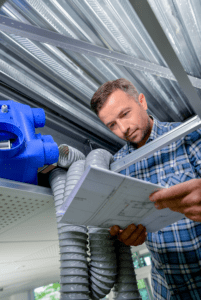When it comes to picking out and installing commercial central air conditioning units, it’s essential to think about the various design features and factors that can impact the performance and efficiency of the system. Commercial HVAC technology is continuing to evolve, and each evolution is bringing new benefits to the table which building owners can use to achieve more effective, balanced, efficient, and reliable cooling. Read on to learn more about some of the design factors that should be on your consideration list as you pick out a cooling/heating system for your commercial building.
The Design Basics of Commercial Central Air Conditioning Units
 Commercial central air conditioning units are one of four common ways to cool a commercial building. Two of these system types—duct-free split system air conditioners and ductless mini-split system air conditioners—are mostly intended for smaller spaces.
Commercial central air conditioning units are one of four common ways to cool a commercial building. Two of these system types—duct-free split system air conditioners and ductless mini-split system air conditioners—are mostly intended for smaller spaces.
Commercial central air designs typically utilize either a split-system design or are “packaged” units. In a split system, there is an indoor unit and an outdoor unit, linked together by a refrigerant tube. The indoor unit includes a fan, a cooling coil, and a filter. The outdoor section consists of a compressor and a condenser. Working together, these units cool the air and then distribute it through a series of ducts that winds throughout the building. These systems are known for their efficiency and are very effective at achieving consistent, balanced temperatures in all different parts of a building.
Packaged system air conditioners work similarly, with the difference being that all the components are included in a single unit. For most commercial buildings, these systems are on the roof. Similar to split systems, they use ductwork to deliver cooled air throughout the building.
Choosing the Right Commercial Air Conditioning System
While the two types of ducted commercial air conditioning units operate in relatively similar ways, it’s important to understand that individual units are going to offer different kinds of benefits. Here are a few additional design details to pay attention to when picking out a commercial air conditioning system:
- Size: The size of your air conditioning system is going to have a direct impact on its ability to meet the cooling needs of your building. A unit that is too small won’t be able to deliver the cooling load your building needs. A unit that is too big will turn on and off frequently as it attempts to match the thermostat temperature, leading to energy efficiency problems, big temperature inconsistency issues, and high levels of humidity throughout your building.
- Special features: Depending on what air conditioning unit you choose, you may be able to take advantage of state-of-the-art features or technologies. One example is VRF, or variable refrigerant flow. VRF links multiple indoor units to an outdoor condenser, allowing more zone-to-zone temperature control for your system. Other air conditioning units might advertise power-saving modes, low-volume operation, and more. Be sure to research features and specifications thoroughly, to know what each air conditioning unit design brings to the table.
- Duct and thermostat features: An efficient, effective commercial air conditioning system goes beyond the air conditioning unit itself. Specifically, both the thermostat(s) in your building and the design of the ductwork are important. A programmable “smart” thermostat will give you more control over your system and enable you to be more strategic with how you are cooling your building at different times of the day or week. As for ducts, even if you don’t have a VRF air conditioning system, you can still accomplish temperature zone control by installing dampers in your ducts. These dampers respond to different thermostats placed throughout your building, opening or shutting automatically based on which thermostats are calling for cold air.
- Other building improvements: While not technically related to the design of your air conditioning unit at all, numerous building improvements can affect the performance of your unit, the efficiency of your HVAC system, and your overall cost for cooling your building. Checking the insulation in your building—particularly around the ductwork—can limit heat transfer and assist with unit efficiency. Installing energy-efficient windows can yield similar benefits. Using automatic blinds to screen windows during sunny parts of the day will limit the impact of the sun on the interior temperature, which will mean that there is less temperature fluctuation throughout the day. Finally, scheduling regular unit maintenance—and regular duct cleaning—will help you spot upkeep issues and keep your system operating in peak mode.
Call an HVAC Technician for Help Building the Right Commercial Air Conditioning System
A skilled and reputed HVAC contractor can help you with everything discussed above. They can recommend different brands of air conditioning units, assist you with unit sizing, handle your maintenance and duct cleaning services, and answer any questions you might have about the design of different commercial central air conditioning units. Call your preferred HVAC company today for help.

